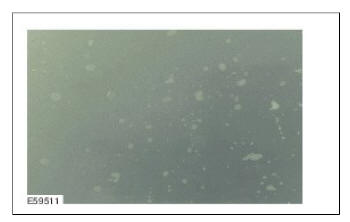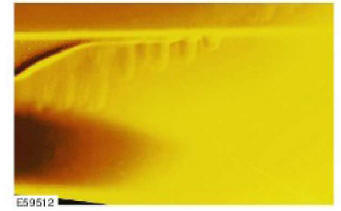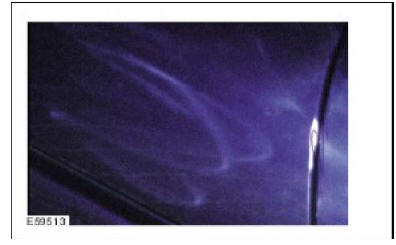 Ford Kuga Service ManualPaint - General Information » Paintwork Defects and Damage
Ford Kuga Service ManualPaint - General Information » Paintwork Defects and Damage
Damage caused by faults in treatment
Damage caused by faults in treatment
- Craters
- Paint boils
- Adhesion defects
- Adhesion defects - clear lacquer
- Sanding scores
- Formation of stripes
- Peeling/blistering on plastic parts
- Blistering on polyester material
- Peroxide marks in metallic paints
- Crack formation
- Shrinking back/zone edge marks
- Blistering
- Etching
- Paint wrinkles/puckering
- Cloud formation
- Spots/metallics
- Metamerism/color deviations
- Washing out
- Loss of gloss
- Covering ability/areas of thin paint
- Flow problems/orange peel
- Dirt embedded in metallic base paint
- Dirt embedded in top coat
- Water marks
- Paint runs
- Swirl marks
Craters
Crater-like single or extensively occurring depressions with raised edges, in top coat or the r intermediate layers.
Cause/damage pattern:
- Substrate not adequately cleaned with silicone remover.
- Spray air contaminated by oil residues and water accumulations.
- Filter ceiling not adequate for requirements.
- Use of polishes, cleaning agents or sprays (e.g.
interior sprays) containing silicone
- Oil, wax, grease, silicone containing residues.
- Working clothes contaminated by materials containing silicone.

Repair of damage:
- Sand paint surface, clean with silicone remover and apply one thin spray pass. Let it begin to dry well, then apply several thin and dry sprayed passes.
Paint boils
Small, hard, closed or burst blisters in the paint top coat. They appear locally in groups or spread individually across the whole surface. Sanding opens up a larger cavity, under which the primer can often be seen.
Cause/damage pattern:
- Paint applied in layers which were too thick.
- Specified flash-off and drying times between coats were not adhered to.
- Specified working viscosity and spray pressure were not adhered to.
- Use of unsuitable hardener and thinner materials. (Solvent combinations in paint system not optimally matched).
- Poor booth conditions.

Repair of damage:
- Single boil blisters can be removed using polishing.
- After thorough drying, sand the top coat at the affected areas, clean with silicone remover and re-paint. Fill any fine pores still present with 2-component acrylic filler.
- On larger areas of damaged topcoat, sand completely away and apply new paint finish.
Adhesion defects
Whole coating detached from substrate or individual layers one from another. Sometimes adhesion defects can only be noticed after an external influence such as stone impact.
Cause/damage pattern:
- Substrate not adequately prepared (rust, grease, moisture, sanding, cleaning).
- Unsuitable material used.
- Drying times, flash-off times too short.
- Base paint not sprayed wet-in-wet, instead the intermediate drying times were too long.
- Failure to intermediate sand.
- Condensation formed because of temperature fluctuations.
- Unprofessional preparation (especially on plastics).
- Overheated CDP/intermediate filler.

Repair of damage:
- Sand out the damage and recreate the paint finish. Create the paint finish strictly in accordance with the general technical information.
Adhesion defects in clear lacquer.
Clear lacquer detched from base paint.
Cause/damage pattern:
- Base paint layer too thick.
- Intermediate and final flash-off times of base paint too long.
- Incorrect mixture ratio clear lacquer/hardner.

Repair of damage:
- Refinish sanding and recreate the paint finish.
Sanding scores
Single or wide area clusters of scoring or sanding marks, often with raised edges. Noticeable on metallic paints as light-dark stripes.
Cause/damage pattern:
- Stopper sanded too coarsely.
- Filler sanded too coarsely.
- Filler not thoroughly dried bfore sanding.
- Old paint sanded too coarsely.
- Soft elastic substrates, e.g. TPA base, treated with thinners which was too aggressive and therefore etched.
- Top coat applied too thinly.

Repair of damage:
- If the damage pattern is minimal, after the top coat has dried fine sand the paint surface and refurbish by polishing.
- If the damage is great or on metallic paints, sand the paint surface or substrates and if necessary remove them, then cover the bare metal and re-paint.
Formation of stripes
Differing, stripe shaped color/effect formations in dark/light areas of a metallic paint finish.
Cause/damage pattern:
- Spray gun (nozzle) not perfect.
- Incorrect spray pressure.
- Thinners not suitable
- Incorrect spray viscosity.
- Flash-off time too short.
- Unsuitable working temperature.

Repair of damage:
- Apply base paint evenly.
- Repair spray gun.
- After clear lacquer has thoroughly dried, sand surface and paint again.
Peeling/blistering on plastic parts
Paint adhesion insufficient between top coat and filler and/or primer layer. It often happens that the whole of the paint finish detaches from the plastic.
Cause/damage pattern:
Plastic item not cleaned sufficiently, not or inadequately tempered.
Unsuitable cleaning agent used.
Unsuitable materials used.
Moisture.
Paint finish underbaked oroverbaked.
Poor or lack of intermediate sanding.

Repair of damage:
- Sand away faulty paint coats and re-apply paint finish.
- In extreme cases use a new part.
Blistering on polyester material
Color shade differences or marks in paintwork subsequently applied to previously unpainted plastic material.
Cause/damage pattern:
- Plastic material is not suitable for painting
- Incorrect bonding agent.
- Paint used not solvent resistant.
Repair of damage:
- Repaint using suitable materials.
- Install unpainted new part (after consulting customer).
Peroxide marks in metallic paints
After longer period of drying, abnormal marks where the color shade varies.
Cause/damage pattern:
- Too much hardener added to polyester stopper (over 3% can cause this damage pattern).
- Polyester stopper not well enough mixed.

Repair of damage:
- Sand, fill with polyester or epoxide filler and re-paint.
Crack formation
Cracks of different lengths and depths running in all directions.
Cause/damage pattern:
- Layers too thick.
- Painted several times.
- Temperature fluctuations.
- Mechanical effects e.g. distortions.
- Substrate not thoroughly hardened.
- Old paint not completely dried out.
- No or insufficient hardener added.
- 2-component materials used on nitro or TPA.

Repair of damage:
- Sand away layers until sound substrate is reached and create new paint finish (prime, fill, apply topcoat).
Shrinking back/zone edge marks
Lifting or dropping in of edge zones (edges which accentuate themselves in the top coat), flow problems and loss of shine in top coat.
Cause/damage pattern:
- Old paintwork not rubbed down to a seamless transition.
- Stopper and filler on a viscoplastic base primer.
- Filler sanded and overpainted when not thoroughly hard.
- Previous materials overworked too early, substrate not sufficiently hardened.
- Primer applied in layers which were too thick, and not dried for long enough.
- Sanding paper too coarse.
- Top coat thinned too much.

Repair of damage:
- After hardening off the top coat, fine sand the surface and polish up, apply filler if necessary and paint once more.
Blistering
Small, spot-like, air-filled or water-filled blister shaped high-spots in the paint construction. Their dimensions can range from pin-head to pin-point size in a closed paint film. Arrangement and accumulation very variable. In the advanced stages, circular flaking of the paint from the substrate. These are neither boils nor corrosion.
Cause/damage pattern:
- Moisture absorption by substrate.
- Insufficient drying of the substrate after wet sanding (especially on polyester material).
- Humidity too high before painting; condensation formation because of temperature fluctuations.
- Pores/sink holes in substrate not sanded out.
- Polyester material not covered.
- Sweat from hands.
- Salts and minerals in sanding water.
- Spray air contaminated.

Repair of damage:
- Sand away damage, matt sand remainder of surface, clean with silicone remover, fill and re-paint.
Etching
The base paint is etched by the clear lacquer. This causes the aluminum pigments to change their alignments. The color of the etched base paint seems more grey than that of normal base paint.
Result is that the surface structure of the clear lacquer becomes increasingly more matt.
Cause/damage pattern:
- Base painted too wet.
- No intermediate flash-off time.
- Layers too thick.

Repair of damage:
- Sand and re-paint
Paint wrinkles/puckering
Lifting/puckering of the paint surface.
Cause/damage pattern:
- First paint not hardened through or can be etched.
- Areas of clear lacquer which were sanded through to base paint have not been not isolated with filler, or with unsuitable filler.
- Unsuitable substrate (e.g. spray can painting with TPA or nitro).
- Use of unsuitable primer, paint and thinner materials.
- Paint systems not matched to each other.
- In wet-in-wet process, specified flash-off times not adhered to.
- Synthetic resin top coat (alkyd resin) worked over too soon.

Repair of damage:
- After thorough drying, completely remove the top coat together with the attacked substrate at the affected areas and re-create a new paint finish.
- Before applying top coat, rub down the complete surface.
Cloud formation
Differing, blotchy color/effect formations in dark/light areas of a metallic paint finish.
Cause/damage pattern:
- Spray gun, spray nozzle, spray pressure not perfect.
- Varying spray viscosity, spraying method, flash-off times, spray booth temperature.
- Thinners not suitable.

Repair of damage:
- Droplet method before clear lacquer application.
- After clear lacquer has thoroughly dried, sand surface and re-paint.
Spots
Points rising up from the paint film.
Cause/damage pattern:
- Metallic base paint sprayed too dry, so that the metal particles could not incorporate into the paint. The clear lacquer could not cover these vertical standing particles because the spray air was too hot or the booth temperature was too high.

Repair of damage:
- After the paint surface has dried, lightly sand it with grade P800 sanding paper, clean with silicone remover and re-apply clear lacquer.
Metamerism/color deviations
Noticeable when identical color shades undergo a change of hue as the light source changes (daylight/artificial light). Different pigment composition between original and repair paint.
Cause/damage pattern:
- Use of paints with pigmentation which was not compatible with the standard, e.g. a green can be formulated from yellow and blue, or directly from green.
- Use of an unsuitable mixed or ready made paint to re-tone.

Repair of damage:
- Repaint using the correct paint.
Washing out
On paint which has been newly applied but not yet dried, the interaction of surface tension and very different specific gravities of the different pigments can lead to swirl-like turbulence which results in separation of the pigments.
Cause/damage pattern:
- Layer too thick, paint not stirred enough.

Repair of damage:
- Sand and re-paint.
Loss of gloss
Milky, dreary tarnishing of the paint with more or less even loss of gloss.
Cause/damage pattern:
- Cold with low air humidity.
- Heat with high air humidity.
- Substrate can be etched.
- Hardener fault or wrong hardener used.
- Paint thinned too much.
- Proportion of pigment too high because of poor stirring.
- Not optimum drying.

Repair of damage:
- After drying, remove the matt effect by polishing.
If unsuccessful, rub down complete area and paint again.
Covering ability/areas of thin paint
Different color shades in the surface. The minimum layer thickness is not achieved here. The effects range from local minor shade variations through mottled spray zones to completely missing top coat.
Cause/damage pattern:
- No correct, uniform substrate (effect paint).
- On three-layer systems, wrong filler.
- Insufficient top coat application.

Repair of damage:
- Sand surface and recreate the paint finish.
Flow problems/orange peel
Surface structure bumpy, grained. The surface is similar to the peel of an orange.
Cause/damage pattern:
- Paint viscosity too high.
- Use of fast evaporating, highly volatile thinners.
- Booth temperature too high.
- Spray gun distance too great, too little material applied.
- Nozzle too large.
- Incorrect spray pressure

Repair of damage:
- Small surfaces: fine sand and polish.
- Sand out the surface and recreate the paint finish.
Dirt embedded in metallic base paint.
Inclusions of contamination in metallic base paint, of different sizes and shapes (grains or lint).
Cause/damage pattern:
- Dust was not properly removed from the surface to be painted.
- Paint material not sieved.
- Function of the painting facilities not optimum.
- Filter contaminated.
- Wearing unsuitable clothing.
Repair of damage:
- Sand and repaint.
Dirt embedded in top coat
Inclusions of contamination in top coat or under paint layers, of different sizes and shapes (grains or lint). Optical adverse effect.
Cause/damage pattern:
- Dust was not properly removed from the surface to be painted.
- Paint material not sieved.
- Function of the painting facilities not optimum.
- Filter contaminated.
- Wearing unsuitable clothing.

Repair of damage:
- Single inclusions: after thorough hardening, sand out using 1200 - 1500 grade paper and repolish using a suitable silicone-free sanding or painting paste.
- Large area contamination: sand and repaint.
Water marks
Ring shaped marks appearing on the paint surface.
Cause/damage pattern:
Evaporation of water droplets on freshly painted and not yet fully hardened paint finishes (mostly only found on horizontal surfaces).
- Layer too thick.
- Drying time too short.
- Hardening faults or hardener no longer useable.
- Use of unsuitable thinners.

Repair of damage:
- Rub down only slight marks with sanding paper grade P1000 - P1200 and then polish.
- For heavy marking, sand the surface matt, clean with silicone remover and repaint.
Paint runs
Wave-like paint run tracks in top coat or in an intermediate layer on vertical surfaces. Mostly in the area of swage lines, seams or openings (there they are paint runs, otherwise curtains).
Cause/damage pattern:
- Uneven paint application.
- The specified viscosity was not complied with.
- Use of unsuitable thinner materials.
- Air, material or room temperature too low.
- Layers too thick.
- Spray gun (nozzle) not perfect.

Repair of damage:
- After thorough drying, sand unevenness flat, if necessary leave to dry afterwards.
- Small areas of damage can be equalised using the paint plane, then sand, polish or repaint.
Swirl marks
Three dimensional appearance in the paint surface in the form of smears or blotches. This effect is intensified in direct sunlight.
Cause/damage pattern:
- Polishing using polishing machine on paint which has not yet hardened throughout.
- Polishing intervals too long or none at all.
- Pressure too high while polishing.
- Incorrect polishing material or polishing tool.

Repair of damage:
- Allow the paint to harden completely and then polish.
- If the damage is irreversible, rub down and apply new clear lacquer.
Diagnosis and Damage Assessment
Paint damage guide
Paint damage caused by environmental factors
Mechanical damage
Damage due to corrosion
Damage caused by faults in treatment
Ford Kuga Service Manual
- General Information
- Jacking and Lifting
- Noise, Vibration and Harshness
- Suspension System - General Information
- Climate Control
- Auxiliary Climate Control
- Instrument Cluster and Panel Illumination
- Instrument Cluster
- Horn
- Warning Devices
- Parking Aid
- Charging System - General Information
- Battery, Mounting and Cables
- Generator and Regulator
- Voltage Converter/Inverter
- Information and Entertainment System - General Information
- Information and Entertainment System
- Exterior Lighting
- Interior Lighting
- Daytime Running Lamps (DRL)
- Module Communications Network
- Module Configuration
- Wiring Harnesses
- Anti-Theft - Active
- Anti-Theft - Passive
- Multifunction Electronic Modules
- Front End Body Panels
- Body Closures
- Interior Trim and Ornamentation
- Exterior Trim and Ornamentation
- Rear View Mirrors
- Seating
- Glass, Frames and Mechanisms
- Instrument Panel and Console
- Handles, Locks, Latches and Entry Systems
- Wipers and Washers
- Bumpers
- Safety Belt System
- Supplemental Restraint System
- Body Repairs - General Information
- Body Repairs - Vehicle Specific Information and Tolerance Checks
- Front End Sheet Metal Repairs
- Roof Sheet Metal Repairs
- Side Panel Sheet Metal Repairs
- Rear End Sheet Metal Repairs
- Paint - General Information
- Uni-Body, Subframe and Mounting System
- Suspension System - General Information
- Front Suspension
- Rear Suspension
- Wheels and Tires
- Driveshaft
- Rear Drive Axle/Differential
- Front Drive Halfshafts
- Rear Drive Halfshafts
- Brake System - General Information
- Front Disc Brake
- Rear Disc Brake
- Parking Brake and Actuation
- Hydraulic Brake Actuation
- Power Brake Actuation
- Anti-Lock Control
- Anti-Lock Control - Stability Assist
- Steering System - General Information
- Power Steering
- Steering Linkage
- Steering Column
- Steering Column Switches
- Engine System - General Information
- Engine- 2.5L Duratec (147kW/200PS) - VI5
- Engine Cooling
- Fuel Charging and Controls-2.5L Duratec (147kW/200PS) - VI5
- Fuel Charging and Controls - Turbocharger- 2.5L Duratec (147kW/200PS) - VI5
- Accessory Drive - 2.5L Duratec (147kW/200PS) - VI5
- Starting System- 2.5L Duratec (147kW/200PS) - VI5
- Engine Ignition - 2.5L Duratec (147kW/200PS) - VI5
- Engine Emission Control - 2.5L Duratec (147kW/200PS) - VI5
- Intake Air Distribution and Filtering - 2.5L Duratec (147kW/200PS) - VI5
- Evaporative Emissions
- Electronic Engine Controls
- Automatic Transmission/Transaxle
- Transmission/Transaxle Cooling
- Automatic Transmission/Transaxle External Controls
- Transfer Case
- Exhaust System-
- Fuel System
- Fuel Tank and Lines
- Acceleration Control
- Speed Control
- Climate Control System
- Climate Control
Main Categories
0.008
